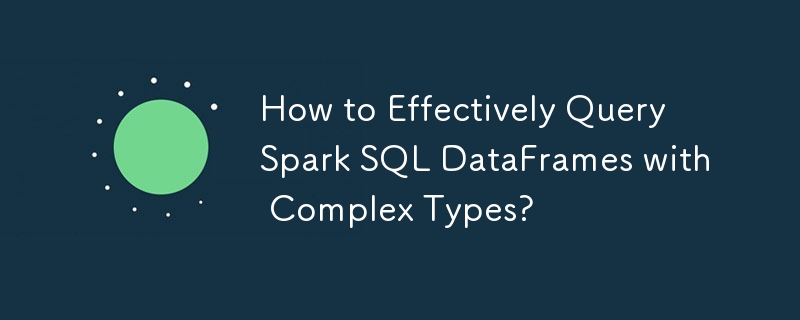How to Effectively Query Spark SQL DataFrames with Complex Types?

Efficiently Querying Spark SQL DataFrames with Complex Data Types
Working with complex data types like arrays and maps in Spark SQL DataFrames can present unique challenges. This guide outlines effective strategies for retrieving data from these structures.
Querying Array Columns:
Several methods exist for accessing array elements:
-
getItemMethod: Directly access an element using its index. -
Hive Bracket Notation: Use square brackets (
[]) to specify the element's index. - User-Defined Functions (UDFs): Create custom functions for more complex element extraction logic.
-
Higher-Order Functions: Leverage functions like
transformfor element-wise manipulations. -
Built-in Array Functions: Utilize functions such as
array_distinctfor specific array operations.
Accessing Map Columns:
Retrieve map values using these techniques:
-
getFieldMethod: Access a value using its associated key. - Hive Bracket Notation: Directly access values within the query using key-value syntax.
- Dot Notation: Use a fully qualified path to navigate to the desired value.
- UDFs: Employ UDFs for more intricate value retrieval.
-
Map Functions: Utilize functions like
map_keysandmap_valuesfor key and value extraction.
Working with Struct Columns:
Access fields within struct columns using:
- Dot Notation (DataFrame API and SQL): Use period-separated paths to traverse the struct's hierarchy.
Navigating Nested Structures:
Accessing fields within nested arrays or structs involves:
- Dot Notation: Chain periods to access nested fields.
-
getItemMethod: Extract array elements using their indices. - UDFs: Define UDFs for handling complex nested access patterns.
Handling User-Defined Types (UDTs) and Nested Values:
- UDFs for UDT Access: Use UDFs to query fields of user-defined types.
- Schema Flattening and Exploding: Consider restructuring your schema by flattening or exploding collections to simplify queries.
Additional Considerations:
- Depending on your Spark version,
HiveContextmay be necessary for certain operations. - Wildcard characters can be incorporated into dot notation for flexible field selection.
- Specialized functions like
get_json_objectandfrom_jsonare available for querying JSON columns.
The above is the detailed content of How to Effectively Query Spark SQL DataFrames with Complex Types?. For more information, please follow other related articles on the PHP Chinese website!

Hot AI Tools

Undresser.AI Undress
AI-powered app for creating realistic nude photos

AI Clothes Remover
Online AI tool for removing clothes from photos.

Undress AI Tool
Undress images for free

Clothoff.io
AI clothes remover

AI Hentai Generator
Generate AI Hentai for free.

Hot Article

Hot Tools

Notepad++7.3.1
Easy-to-use and free code editor

SublimeText3 Chinese version
Chinese version, very easy to use

Zend Studio 13.0.1
Powerful PHP integrated development environment

Dreamweaver CS6
Visual web development tools

SublimeText3 Mac version
God-level code editing software (SublimeText3)

Hot Topics
 1376
1376
 52
52
 How do you alter a table in MySQL using the ALTER TABLE statement?
Mar 19, 2025 pm 03:51 PM
How do you alter a table in MySQL using the ALTER TABLE statement?
Mar 19, 2025 pm 03:51 PM
The article discusses using MySQL's ALTER TABLE statement to modify tables, including adding/dropping columns, renaming tables/columns, and changing column data types.
 How do I configure SSL/TLS encryption for MySQL connections?
Mar 18, 2025 pm 12:01 PM
How do I configure SSL/TLS encryption for MySQL connections?
Mar 18, 2025 pm 12:01 PM
Article discusses configuring SSL/TLS encryption for MySQL, including certificate generation and verification. Main issue is using self-signed certificates' security implications.[Character count: 159]
 What are some popular MySQL GUI tools (e.g., MySQL Workbench, phpMyAdmin)?
Mar 21, 2025 pm 06:28 PM
What are some popular MySQL GUI tools (e.g., MySQL Workbench, phpMyAdmin)?
Mar 21, 2025 pm 06:28 PM
Article discusses popular MySQL GUI tools like MySQL Workbench and phpMyAdmin, comparing their features and suitability for beginners and advanced users.[159 characters]
 How do you handle large datasets in MySQL?
Mar 21, 2025 pm 12:15 PM
How do you handle large datasets in MySQL?
Mar 21, 2025 pm 12:15 PM
Article discusses strategies for handling large datasets in MySQL, including partitioning, sharding, indexing, and query optimization.
 How do you drop a table in MySQL using the DROP TABLE statement?
Mar 19, 2025 pm 03:52 PM
How do you drop a table in MySQL using the DROP TABLE statement?
Mar 19, 2025 pm 03:52 PM
The article discusses dropping tables in MySQL using the DROP TABLE statement, emphasizing precautions and risks. It highlights that the action is irreversible without backups, detailing recovery methods and potential production environment hazards.
 Explain InnoDB Full-Text Search capabilities.
Apr 02, 2025 pm 06:09 PM
Explain InnoDB Full-Text Search capabilities.
Apr 02, 2025 pm 06:09 PM
InnoDB's full-text search capabilities are very powerful, which can significantly improve database query efficiency and ability to process large amounts of text data. 1) InnoDB implements full-text search through inverted indexing, supporting basic and advanced search queries. 2) Use MATCH and AGAINST keywords to search, support Boolean mode and phrase search. 3) Optimization methods include using word segmentation technology, periodic rebuilding of indexes and adjusting cache size to improve performance and accuracy.
 How do you represent relationships using foreign keys?
Mar 19, 2025 pm 03:48 PM
How do you represent relationships using foreign keys?
Mar 19, 2025 pm 03:48 PM
Article discusses using foreign keys to represent relationships in databases, focusing on best practices, data integrity, and common pitfalls to avoid.
 How do you create indexes on JSON columns?
Mar 21, 2025 pm 12:13 PM
How do you create indexes on JSON columns?
Mar 21, 2025 pm 12:13 PM
The article discusses creating indexes on JSON columns in various databases like PostgreSQL, MySQL, and MongoDB to enhance query performance. It explains the syntax and benefits of indexing specific JSON paths, and lists supported database systems.




